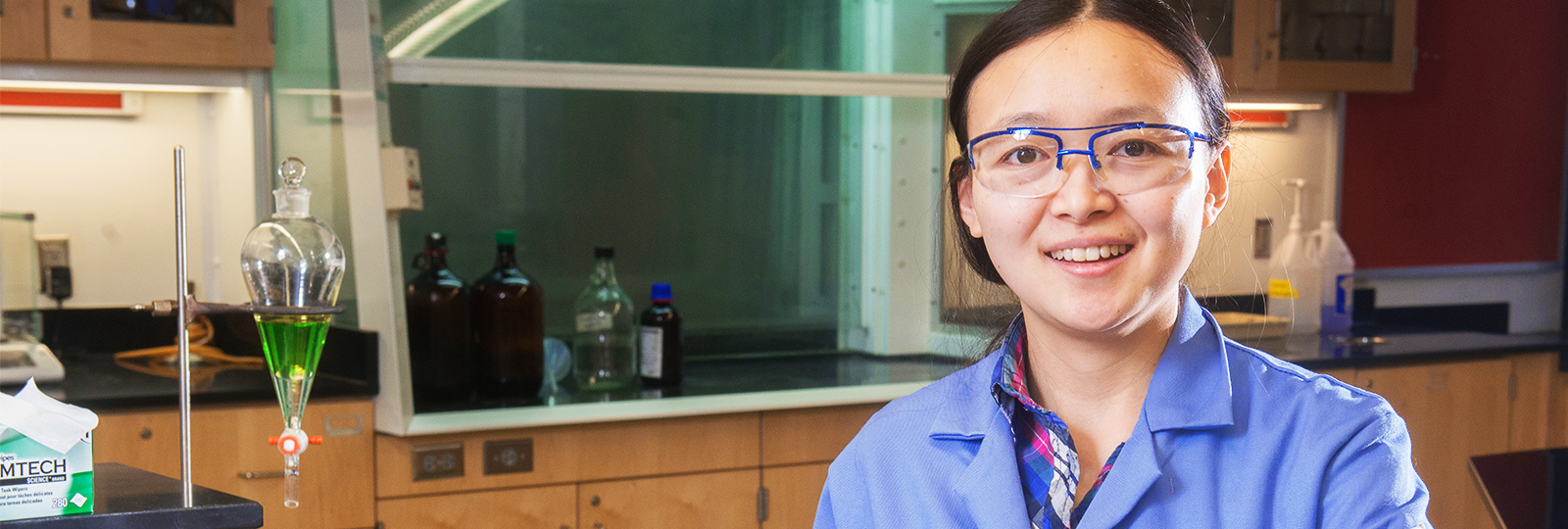
Xin Shang, a graduate student in Dr. Jiantao Guo’s lab, has been conducting research at the interface of chemistry and biology and is developing new chemical tools to facilitate biological and biomedical investigations.
Shang wants to improve the pharmaceutical drugs used to fight multiple diseases.
She wants to make a difference.
“I’m not sure if I can improve human life a lot, but I feel like I can help,” Shang said.
“I have an opportunity to make a difference.”
Her Research
One of Shang’s biggest milestones came in 2016 when she was the lead-author on a publication in Chemical Science. Her research focused on the development of fluorogenic protein labeling based on the inverse electron-demand Diels-Alder reaction between styrene, an unstrained alkene, and a tetrazine. This reaction created a new fluorophore, and once in the biological system, tetrazine reacts with proteins that contain an unnatural amino acid (KStyr). This process allows for protein labeling in live cells, which can potentially be applied to the study of protein folding and function under physiological conditions.
Shang said Nebraska Chemistry’s Research First philosophy allowed her get started on her research the minute she arrived.
“The department provides many opportunities for you to start your research,” Shang said. “We get support in the lab from the first semester until the end.”
She has completed her work on the tetrazine and alkene reaction and is currently working on a tetrazole and alkene reaction.
Shang’s appreciation for the interaction between chemistry and biology has continued to grow since she started her research, and it’s done so because she can visualize the real-world applications for what she’s discovering. For example, her current research can be applied to Antibody Drug Conjugates, which is a fast-growing area within the drug industry. By developing new methodologies on the introduction of unique chemical handles into proteins, she can help with the drug production and make a difference in the pharmaceutical world.
Shang has also co-authored publications in RCS Advances and Scientific Reports.
Finding Her Passion
Shang’s freedom to conduct her research at Nebraska has led her to develop a deeper appreciation and interest for chemical biology.
“The Ph.D. program paves a solid road for you to become an independent researcher,” Shang said. “I found my curiosity toward the world at Nebraska.”
Shang’s curiosity goes beyond the field of chemical biology, so she has taken advantage of one of Nebraska’s many interdisciplinary opportunities by attending monthly seminars hosted by the Molecular Mechanisms of Disease (MMoD) program. The interdisciplinary seminars led by Dr. Melanie Simpson of the biochemistry department cover topics related to chemistry, biochemistry, biology, nutrition sciences, and any other discipline associated with the MMoD program.
The seminars have opened Shang’s eyes to how her research can impact other disciplines.
“You learn how different areas interact with each other, so I want to put more energy and passion into chemical biology,” Shang said.
Future Plans
With aspirations of graduating in May 2017, Shang has started to consider life after Nebraska. She hopes to settle into a postdoctoral position immediately after graduating, as she still thinks there is much to discover. Her long-term goal is to become an independent researcher, a career she feels Nebraska Chemistry has prepared her for.
Publications:
- Shang, X.; Song, X.; Faller, C.; Lai, R.; Li, H.; Cerny, R.; Niu, W.; Guo, J. “Fluorogenic Protein Labeling Using A Genetically Encoded Unstrained Alkene” Chem. Sci. 2016, DOI: 10.1039/C6SC03635J
- Song, X., Shang, X.; Ju, T.; Niu, W., Guo, J. “A Photoactivable Src Homology 2 (SH2) Domain” RCS Advances 2016, 6, 51120-51124
- Wang, N.; Shang, X.; Cerny, R.; Niu, W.; Guo, J. “Systematic Evolution and Study of UAGN Decoding tRNAs in a Genomically Recoded Bacteria.” Sci. Rep. 2016, 6, 21898.
Selected Presentations:
- Oral presentation at Molecular Mechanism of Disease Seminar, Lincoln, NE, October 2016
- Oral presentation at the 250th ACS National Meeting, Boston, MA, August 2015